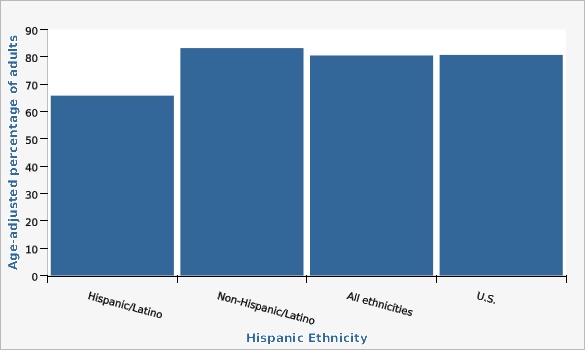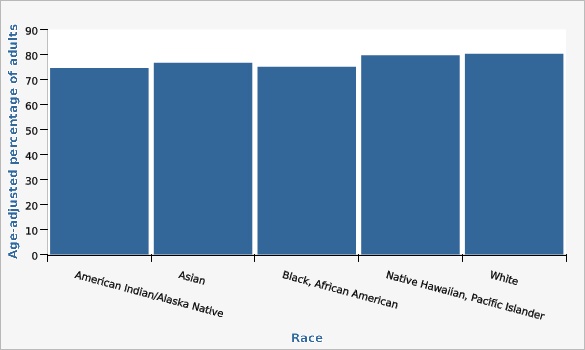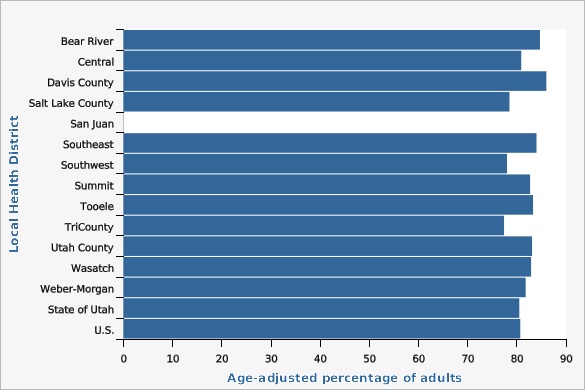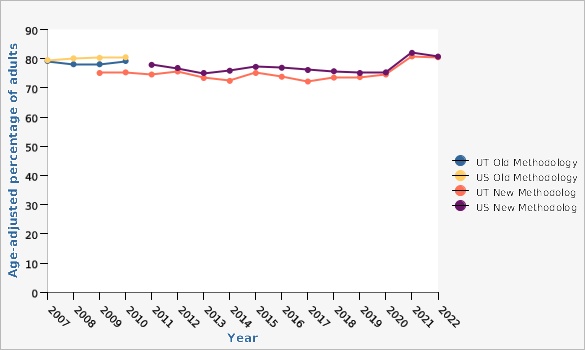Complete Health Indicator Report of Personal Doctor or Health Care Provider
Definition
Percentage of adults who reported having one or more persons they think of as their personal doctor or health care provider.Numerator
Number of adults who reported having at least one person they think of as their personal doctor or health care provider.Denominator
Total number of adults interviewed during the same survey period.Data Interpretation Issues
Question Text: "Do you have one person you think of as your personal doctor or health care provider?" Respondents can answer "Yes, only one", "Yes, more than one" or "No." For this indicator, the two "Yes" responses have been combined. Beginning in 2011, BRFSS data include both landline and cell phone respondent data along with a new weighting methodology called iterative proportional fitting, or raking. This methodology utilizes additional demographic information (such as education, race, and marital status) in the weighting procedure. Both of these methodology changes were implemented to account for an increased number of U.S. households without landline phones and an under-representation of certain demographic groups that were not well-represented in the sample. More details about these changes can be found at: [https://ibis.health.utah.gov/pdf/opha/resource/brfss/RakingImpact2011.pdf]. As with all surveys, some error results from nonresponse (e.g., refusal to participate in the survey or to answer specific questions) and measurement (e.g., social desirability or recall bias). Error was minimized by use of strict calling protocols (up to 15 calls were made to reach each household), good questionnaire design, standardization of interviewer behavior, interviewer training, and frequent, on-site interviewer monitoring and supervision.Why Is This Important?
As each new health care need arises, an individual's first point of contact with the health care system is typically his or her personal doctor. In most cases a personal doctor can effectively and efficiently manage a patient's medical care because they understand that person's medical history and social background. Having a regular source of health care is also an indicator of overall access to care.How Are We Doing?
In 2022, 79.8% (crude rate) of Utah adults reported having at least one person they think of as their personal doctor or health care provider. However, 20.2% of Utahns did not have a personal doctor or health care provider. Lack of a primary care provider was more common among young adults, especially men ages 18 to 34 (only 59.7% reported having a personal doctor) in 2022. In 2020-2022, Salt Lake City (Glendale) V2 (65.9%), West Valley (East) V2 (67.5%), and Salt Lake City (Rose Park) (67.8%) small areas had the lowest age-adjusted rates of people who reported having a primary care provider among all of the 99 Utah Small Areas.How Do We Compare With the U.S.?
In 2022, Utah (80.5%) had a similar age-adjusted rate of persons reporting a primary care provider when compared with the U.S. (80.7%).What Is Being Done?
The Utah Department of Health and Human Services has programs such as Medicaid, Children's Health Insurance Program (CHIP), and Utah's Premium Partnership for Health Insurance (UPP) to pay health care costs for low-income children and adults and those with disabilities.Available Services
MEDICAID: In the Salt Lake City area, call (801) 538-6155[[br]] In Utah, Idaho, Wyoming, Colorado, New Mexico, Arizona, and Nevada, call toll-free (800) 662-9651[[br]] From other states, call (801) 538-6155[[br]] Medicaid Customer Service staff are available to take inquiries.[[br]] [[br]] CHIP: Children's Health Insurance Program (for children 0-18)[[br]] Call the Health Resource Line: (888) 222-2542 for information on CHIP.[[br]] Or visit the CHIP website at [http://chip.health.utah.gov/] [[br]]Related Indicators
Relevant Population Characteristics
Lack of a primary provider was more common among young adults, especially men aged 18 to 34 (only 59.7% reported having a personal doctor) in 2022.Related Relevant Population Characteristics Indicators:
Related Health Care System Factors Indicators:
Risk Factors
In 2022, males were significantly less likely than females to have a personal doctor or health care provider (75.5% and 85.5%, respectively, age-adjusted rates).Health Status Outcomes
Persons who have a personal doctor or health care provider are more likely to have routine medical visits and health screenings, such as blood pressure and cancer screening exams. By identifying diseases early, they can be more effectively treated, and disease and disability averted.Related Health Status Outcomes Indicators:
- Blood Cholesterol Screening
- Breast Cancer Screening (Mammography)
- Cervical Cancer Screening (Pap)
- Colorectal Cancer Screening
- Diabetes Hemoglobin A1C Tests
- Fair/poor Health
- Health Status: Mental Health Past 30 Days
- Health Status: Physical Health Past 30 Days
- Prostate Cancer Screening
- Routine Medical Care Visits
Graphical Data Views
| Males vs. Females | Age Group | Percentage of adults | Lower Limit | Upper Limit | ||
|---|---|---|---|---|---|---|
Record Count: 10 | ||||||
| Male | 18-34 | 59.7% | 56.2% | 63.0% | ||
| Male | 35-49 | 75.7% | 72.7% | 78.5% | ||
| Male | 50-64 | 82.7% | 79.7% | 85.3% | ||
| Male | 65+ | 95.4% | 93.7% | 96.6% | ||
| Female | 18-34 | 75.5% | 72.2% | 78.5% | ||
| Female | 35-49 | 86.0% | 83.3% | 88.3% | ||
| Female | 50-64 | 91.5% | 89.3% | 93.2% | ||
| Female | 65+ | 95.2% | 93.4% | 96.5% | ||
Data Source
Utah Department of Health and Human Services Behavioral Risk Factor Surveillance System (BRFSS) [https://ibis.health.utah.gov/ibisph-view/query/selection/brfss/BRFSSSelection.html]| Hispanic Ethnicity | Age-adjusted percentage of adults | Lower Limit | Upper Limit | |||
|---|---|---|---|---|---|---|
Record Count: 4 | ||||||
| Hispanic/Latino | 65.8% | 62.6% | 68.8% | |||
| Non-Hispanic/Latino | 83.2% | 82.1% | 84.2% | |||
| All ethnicities | 80.5% | 79.4% | 81.5% | |||
| U.S. | 80.7% | 80.4% | 81.0% | |||
Data Notes
Age-adjusted to the U.S. 2000 standard population.Data Sources
- Utah Department of Health and Human Services Behavioral Risk Factor Surveillance System (BRFSS) [https://ibis.health.utah.gov/ibisph-view/query/selection/brfss/BRFSSSelection.html]
- Behavioral Risk Factor Surveillance System Survey Data, US Department of Health and Human Services Centers for Disease Control and Prevention (CDC).
| Race | Age-adjusted percentage of adults | Lower Limit | Upper Limit | |||
|---|---|---|---|---|---|---|
Record Count: 5 | ||||||
| American Indian/Alaska Native | 74.6% | 69.7% | 79.0% | |||
| Asian | 76.7% | 71.6% | 81.1% | |||
| Black, African American | 75.1% | 69.6% | 79.8% | |||
| Native Hawaiian, Pacific Islander | 79.7% | 72.9% | 85.1% | |||
| White | 80.3% | 79.7% | 80.9% | |||
Data Notes
Age-adjusted to the U.S. 2000 standard population based on 3 age groups: 18-34, 35-49, and 50+.Data Source
Utah Department of Health and Human Services Behavioral Risk Factor Surveillance System (BRFSS) [https://ibis.health.utah.gov/ibisph-view/query/selection/brfss/BRFSSSelection.html]| Local Health District | Age-adjusted percentage of adults | Lower Limit | Upper Limit | Note | ||
|---|---|---|---|---|---|---|
Record Count: 15 | ||||||
| Bear River | 84.7% | 81.2% | 87.6% | |||
| Central | 80.9% | 74.7% | 85.9% | |||
| Davis County | 86.0% | 82.8% | 88.7% | |||
| Salt Lake County | 78.5% | 76.5% | 80.4% | |||
| San Juan | ** | ** | ||||
| Southeast | 84.0% | 76.8% | 89.3% | |||
| Southwest | 78.0% | 73.7% | 81.8% | |||
| Summit | 82.7% | 74.2% | 88.9% | |||
| Tooele | 83.3% | 77.7% | 87.8% | |||
| TriCounty | 77.4% | 71.3% | 82.6% | |||
| Utah County | 83.1% | 81.0% | 85.1% | |||
| Wasatch | 82.9% | 74.6% | 88.9% | |||
| Weber-Morgan | 81.8% | 78.3% | 84.8% | |||
| State of Utah | 80.5% | 79.4% | 81.5% | |||
| U.S. | 80.7% | 80.4% | 81.0% | |||
Data Notes
Age-adjusted to U.S. 2000 standard population. **Estimates have been suppressed because the relative standard of error is greater than 50%.Data Sources
- Utah Department of Health and Human Services Behavioral Risk Factor Surveillance System (BRFSS) [https://ibis.health.utah.gov/ibisph-view/query/selection/brfss/BRFSSSelection.html]
- Behavioral Risk Factor Surveillance System Survey Data, US Department of Health and Human Services Centers for Disease Control and Prevention (CDC).
| Utah Small Areas | Age-adjusted percentage of adults | Lower Limit | Upper Limit | Note | ||
|---|---|---|---|---|---|---|
Record Count: 100 | ||||||
| Brigham City | 81.8% | 74.5% | 87.3% | |||
| Box Elder Co (Other) V2 | 87.9% | 79.7% | 93.1% | |||
| Tremonton | 83.1% | 74.3% | 89.3% | |||
| Logan V2 | 79.9% | 75.4% | 83.7% | |||
| North Logan | 77.0% | 70.1% | 82.7% | |||
| Cache (Other)/Rich (All) V2 | 80.3% | 73.0% | 85.9% | |||
| Hyrum | 90.5% | 78.9% | 96.0% | * | ||
| Smithfield | 77.4% | 68.4% | 84.4% | |||
| Ben Lomond | 76.3% | 71.7% | 80.4% | |||
| Weber County (East) | 81.6% | 75.5% | 86.4% | |||
| Morgan County | 70.8% | 58.9% | 80.4% | |||
| Ogden (Downtown) | 76.0% | 70.5% | 80.9% | |||
| South Ogden | 76.2% | 70.5% | 81.0% | |||
| Roy/Hooper | 82.3% | 77.0% | 86.6% | |||
| Riverdale | 83.1% | 75.5% | 88.7% | |||
| Clearfield Area/Hooper | 85.3% | 81.3% | 88.7% | |||
| Layton/South Weber | 81.3% | 77.3% | 84.8% | |||
| Kaysville/Fruit Heights | 85.1% | 79.0% | 89.7% | |||
| Syracuse | 85.5% | 79.5% | 90.0% | |||
| Centerville | 84.6% | 74.5% | 91.2% | |||
| Farmington | 81.5% | 72.5% | 88.0% | |||
| North Salt Lake | 84.0% | 75.8% | 89.8% | |||
| Woods Cross/West Bountiful | 82.6% | 73.4% | 89.1% | |||
| Bountiful | 80.6% | 75.6% | 84.9% | |||
| SLC (Rose Park) | 67.8% | 60.0% | 74.7% | |||
| SLC (Avenues) | 79.4% | 71.8% | 85.4% | |||
| SLC (Foothill/East Bench) | 81.5% | 72.6% | 88.0% | |||
| Magna | 76.4% | 69.6% | 82.1% | |||
| SLC (Glendale) V2 | 65.9% | 57.2% | 73.7% | |||
| West Valley (Center) | 76.7% | 71.1% | 81.5% | |||
| West Valley (West) V2 | 81.7% | 75.1% | 86.9% | |||
| West Valley (East) V2 | 67.5% | 61.4% | 73.0% | |||
| SLC (Downtown) V2 | 72.6% | 66.4% | 78.0% | |||
| SLC (Southeast Liberty) | 80.4% | 73.1% | 86.1% | |||
| South Salt Lake | 69.0% | 61.5% | 75.6% | |||
| SLC (Sugar House) | 76.6% | 70.4% | 81.9% | |||
| Millcreek (South) | 72.6% | 64.1% | 79.8% | |||
| Millcreek (East) | 80.0% | 72.8% | 85.8% | |||
| Holladay V2 | 87.5% | 80.1% | 92.4% | * | ||
| Cottonwood | 82.5% | 76.4% | 87.3% | |||
| Kearns V2 | 74.8% | 68.4% | 80.2% | |||
| Taylorsville (E)/Murray (W) | 76.6% | 70.6% | 81.8% | |||
| Taylorsville (West) | 83.2% | 77.4% | 87.8% | |||
| Murray | 73.7% | 66.8% | 79.6% | |||
| Midvale | 76.7% | 70.2% | 82.2% | |||
| West Jordan (Northeast) V2 | 71.4% | 64.2% | 77.7% | |||
| West Jordan (Southeast) | 80.7% | 74.0% | 85.9% | |||
| West Jordan (W)/Copperton | 84.4% | 79.3% | 88.4% | |||
| South Jordan V2 | 78.7% | 72.0% | 84.2% | |||
| Daybreak | 89.0% | 83.3% | 92.9% | |||
| Sandy (West) | 77.4% | 69.0% | 84.0% | |||
| Sandy (Center) V2 | 77.8% | 70.4% | 83.8% | |||
| Sandy (Northeast) | 80.9% | 71.0% | 88.1% | * | ||
| Sandy (Southeast) | 86.3% | 79.6% | 91.0% | |||
| Draper | 83.7% | 78.4% | 88.0% | |||
| Riverton/Bluffdale | 84.7% | 78.9% | 88.1% | |||
| Herriman | 82.4% | 77.2% | 86.7% | |||
| Tooele County (Other) | 77.6% | 69.5% | 84.0% | |||
| Tooele Valley | 81.9% | 78.3% | 85.0% | |||
| Eagle Mountain/Cedar Valley | 78.7% | 72.0% | 84.2% | |||
| Lehi | 82.1% | 78.1% | 85.6% | |||
| Saratoga Springs | 76.9% | 70.7% | 82.2% | |||
| American Fork | 82.8% | 78.5% | 86.4% | |||
| Alpine | 80.6% | 65.7% | 90.0% | * | ||
| Pleasant Grove/Lindon | 81.3% | 76.8% | 85.1% | |||
| Orem (North) | 82.2% | 76.9% | 86.4% | |||
| Orem (West) | 78.4% | 73.2% | 82.8% | |||
| Orem (East) | 82.6% | 75.6% | 87.9% | |||
| Provo/BYU | 83.9% | 78.7% | 88.0% | |||
| Provo (West City Center) | 76.4% | 70.0% | 81.7% | |||
| Provo (East City Center) | 81.1% | 74.8% | 86.1% | |||
| Salem City | 82.5% | 72.7% | 89.4% | * | ||
| Spanish Fork | 77.5% | 72.2% | 82.1% | |||
| Springville | 86.1% | 80.8% | 90.1% | |||
| Mapleton | 90.1% | 81.0% | 95.1% | * | ||
| Utah County (South) V2 | 82.6% | 74.3% | 88.7% | |||
| Payson | 81.8% | 74.8% | 87.2% | |||
| Park City | 76.0% | 69.5% | 81.5% | |||
| Summit County (East) | 80.0% | 72.5% | 85.8% | |||
| Wasatch County | 77.9% | 72.8% | 82.3% | |||
| Daggett and Uintah County | 72.9% | 68.3% | 77.1% | |||
| Duchesne County | 78.6% | 73.5% | 82.9% | |||
| Nephi/Mona | 87.2% | 77.1% | 93.2% | * | ||
| Delta/Fillmore | 83.6% | 73.2% | 90.5% | |||
| Sanpete Valley | 81.0% | 74.9% | 85.9% | |||
| Central (Other) | 76.4% | 70.4% | 81.6% | |||
| Richfield/Monroe/Salina | 89.8% | 83.5% | 93.9% | |||
| Carbon County | 79.7% | 74.2% | 84.2% | |||
| Emery County | 80.1% | 71.6% | 86.4% | |||
| Grand County | 69.8% | 58.9% | 78.8% | |||
| Blanding/Monticello | 79.0% | 71.0% | 85.2% | |||
| San Juan County (Other) | 72.9% | 57.5% | 84.2% | |||
| St. George | 78.1% | 73.9% | 81.8% | |||
| Washington Co (Other) V2 | 75.7% | 63.0% | 85.1% | |||
| Washington City | 77.8% | 69.6% | 84.3% | |||
| Hurricane/La Verkin | 77.1% | 68.9% | 83.7% | |||
| Ivins/Santa Clara | 78.0% | 66.1% | 86.6% | |||
| Cedar City | 72.8% | 66.5% | 78.4% | |||
| Southwest LHD (Other) | 70.2% | 61.7% | 77.6% | |||
| State of Utah | 78.7% | 78.1% | 79.3% | |||
Data Notes
Age-adjusted to U.S. 2000 standard population. *Use caution in interpreting; the estimate has a coefficient of variation > 30% and is therefore deemed unreliable by Utah Department of Health and Human Services standards. A description of the Utah Small Areas may be found on IBIS at the following URL: [https://ibis.health.utah.gov/resource/Guidelines.html].Data Source
Utah Department of Health and Human Services Behavioral Risk Factor Surveillance System (BRFSS) [https://ibis.health.utah.gov/ibisph-view/query/selection/brfss/BRFSSSelection.html]| BRFSS Utah vs. U.S. | Year | Age-adjusted percentage of adults | Lower Limit | Upper Limit | ||
|---|---|---|---|---|---|---|
Record Count: 34 | ||||||
| UT Old Methodology | 2007 | 79.2% | 77.7% | 80.7% | ||
| UT Old Methodology | 2008 | 78.1% | 76.5% | 79.5% | ||
| UT Old Methodology | 2009 | 78.1% | 76.9% | 79.2% | ||
| UT Old Methodology | 2010 | 79.2% | 78.0% | 80.3% | ||
| US Old Methodology | 2007 | 79.5% | 79.2% | 79.8% | ||
| US Old Methodology | 2008 | 80.1% | 79.8% | 80.4% | ||
| US Old Methodology | 2009 | 80.3% | 80.0% | 80.6% | ||
| US Old Methodology | 2010 | 80.5% | 80.2% | 80.8% | ||
| UT New Methodology | 2009 | 75.1% | 74.0% | 76.2% | ||
| UT New Methodology | 2010 | 75.3% | 74.2% | 76.2% | ||
| UT New Methodology | 2011 | 74.6% | 73.6% | 75.6% | ||
| UT New Methodology | 2012 | 75.6% | 74.5% | 76.6% | ||
| UT New Methodology | 2013 | 73.4% | 72.4% | 74.4% | ||
| UT New Methodology | 2014 | 72.4% | 71.5% | 73.3% | ||
| UT New Methodology | 2015 | 75.1% | 74.1% | 76.1% | ||
| UT New Methodology | 2016 | 73.8% | 72.7% | 75.0% | ||
| UT New Methodology | 2017 | 72.2% | 71.0% | 73.2% | ||
| UT New Methodology | 2018 | 73.5% | 72.5% | 74.6% | ||
| UT New Methodology | 2019 | 73.7% | 72.7% | 74.7% | ||
| UT New Methodology | 2020 | 74.6% | 73.5% | 75.7% | ||
| UT New Methodology | 2021 | 80.8% | 79.8% | 81.8% | ||
| UT New Methodology | 2022 | 80.5% | 79.5% | 81.5% | ||
| US New Methodology | 2011 | 77.9% | 77.7% | 78.2% | ||
| US New Methodology | 2012 | 76.8% | 76.5% | 77.0% | ||
| US New Methodology | 2013 | 75.1% | 74.8% | 75.4% | ||
| US New Methodology | 2014 | 75.9% | 75.6% | 76.2% | ||
| US New Methodology | 2015 | 77.2% | 71.9% | 82.5% | ||
| US New Methodology | 2016 | 76.9% | 76.6% | 77.1% | ||
| US New Methodology | 2017 | 76.1% | 75.8% | 76.4% | ||
| US New Methodology | 2018 | 75.7% | 75.4% | 76.0% | ||
| US New Methodology | 2019 | 75.1% | 74.8% | 75.4% | ||
| US New Methodology | 2020 | 75.3% | 75.0% | 75.7% | ||
| US New Methodology | 2021 | 82.0% | 81.7% | 82.3% | ||
| US New Methodology | 2022 | 80.7% | 80.4% | 81.0% | ||
Data Notes
Age-adjusted to the 2000 standard population. Starting in 2009, the BRFSS included both landline and cell phone respondent interviews along with a new weighting methodology called iterative proportional fitting, or raking. More details about these changes can be found at: [https://ibis.health.utah.gov/pdf/opha/resource/brfss/RakingImpact2011.pdf]. Note: At the time of this update, the BRFSS U.S. dataset did not include an age variable but did include five age categories up to age 80+ (vs. the typical weighting scheme that includes 85+). Comparisons with both weighting schemes were compared using Utah data, and the difference was about 1/100 of a percentage point.Data Sources
- Utah Department of Health and Human Services Behavioral Risk Factor Surveillance System (BRFSS) [https://ibis.health.utah.gov/ibisph-view/query/selection/brfss/BRFSSSelection.html]
- Behavioral Risk Factor Surveillance System Survey Data, US Department of Health and Human Services Centers for Disease Control and Prevention (CDC).
More Resources and Links
Evidence-based community health improvement ideas and interventions may be found at the following sites:Additional indicator data by state and county may be found on these Websites:
- CDC Prevention Status Reports for all 50 states
- County Health Rankings
- Kaiser Family Foundation's StateHealthFacts.org
- CDC WONDER DATA2010, the Healthy People 2010 Database.
Medical literature can be queried at the PubMed website.
Page Content Updated On 03/08/2024,
Published on 04/17/2024











